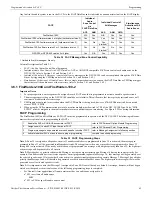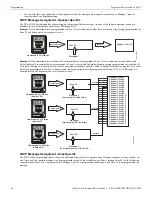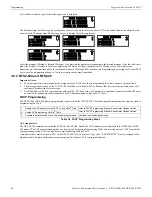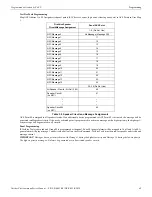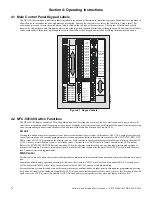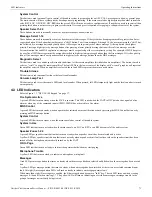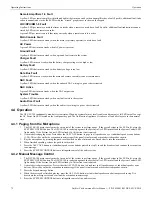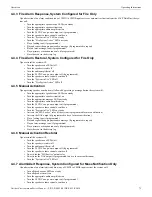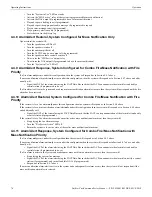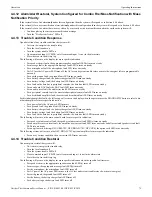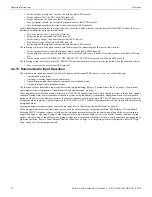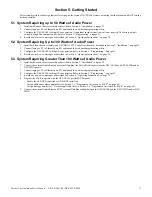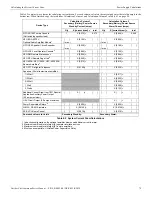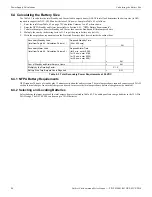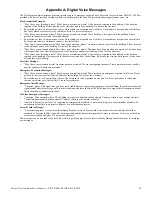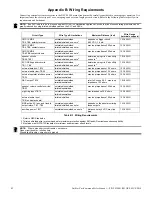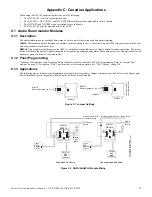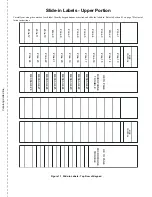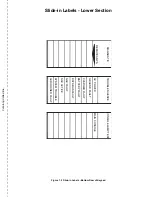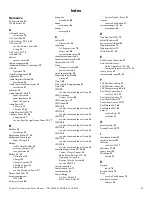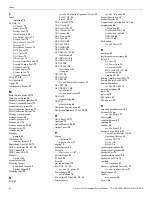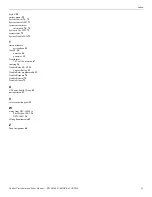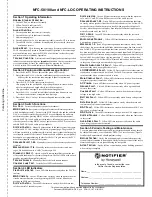
78
Notifier FirstCommand Series Manual —
P/N LS10001-001NF-E:H 1/8/2018
Section 6: Power Supply Calculations
6.1 Overview
This section contains instructions and tables for calculating power supply currents in alarm and standby conditions. This is a four-step
process, consisting of the following:
1.
Calculating the total amount of AC branch circuit current required to operate the system
2.
Calculating the power supply load current for non-fire and fire alarm conditions and calculating the secondary (battery) load
3.
Calculating the size of batteries required to support the system if an AC power loss occurs
4.
Selecting the proper batteries for your system
6.2 Calculating the AC Branch Circuit
The audio distribution panel requires connection to a separate, dedicated AC branch circuit, which must be labeled
FIRE ALARM
. This
branch circuit must connect to the line side of the main power feed of the protected premises. No other non-fire alarm equipment may be
powered from the fire alarm branch circuit. The branch circuit wire must run continuously, without any disconnect devices, from the
power source to the transponder. Over-current protection for this circuit must comply with Article 760 of the National Electrical Codes
as well as local codes. Use 14 AWG (2.00 mm
2
) wire with 600 volt insulation for this branch circuit.
The NFC-50/100 requires 3.5 amps from the AC branch circuit. The NFC-50/100E requires 2.0 amps from the AC branch circuit.
6.3 Calculating the System Current Draw
6.3.1 Overview
The secondary power source (batteries) must be able to power the system during a primary power loss. To calculate the non-fire alarm
load on the secondary power source, use Calculation Column 1 in Table 6.3. The NFC-50/100 must support a larger load current during
a fire alarm condition and primary power loss. To calculate the fire alarm load on the secondary power source, use Calculation Column 2
in Table 6.3.
When calculating current draw and the battery size, note the following:
•
‘Primary’ indicates that the audio panel is being powered by AC
•
‘Secondary’ indicates that the audio panel is being powered by battery backup during AC failure
•
All currents are given in amperes (A) and refer to the DC current being supplied by the panel. Table 6.1 shows how to convert
milliamperes and microamperes to full amperes
6.3.2 How to use Table 6.2 to calculate system current draws
1.
Enter the quantity of devices in both columns.
2.
Enter the DC current draw where required. Refer to the
Notifier Device Compatibility Document
for compatible devices and their
current draw.
3.
Calculate the current draws for each in both columns.
4.
Sum the total current for each column.
5.
Copy the totals from Column 1 and Column 2 to Table 6.3 on page 80.
Following are the types of current that can be entered into Table 6.2:
Calculation Column 1
- The standby current load that the audio panel must support (from the batteries) during a non-fire alarm
condition and a loss of AC power.
Calculation Column 2
- The alarm current draw that the audio panel must support (from the batteries) during a fire alarm
condition and a loss of AC power
To convert....
Multiply
Example
Milliamperes (mA) to amperes (A)
mA x 0.001
3 mA x 0.001 = 0.003 A
Microamperes (µA) to amperes (A)
µA x 0.000001
300 µA x 0.000001 = 0.0003 A
Table 6.1 Converting to Full Amperes
Summary of Contents for Notifier FirstCommand Series
Page 84: ...84 Notifier FirstCommand Series Manual P N LS10001 001NF E H 1 8 2018 Notes ...
Page 86: ...Cut along dotted line ...
Page 88: ...Cut along dotted line ...
Page 92: ...92 Notes ...
Page 94: ...Cut along dotted line ...
Page 96: ...NOTIFIER 12 Clintonville Road Northford CT 06472 1610 USA 203 484 7161 www notifier com ...


